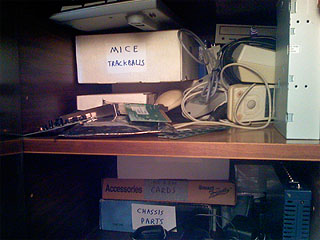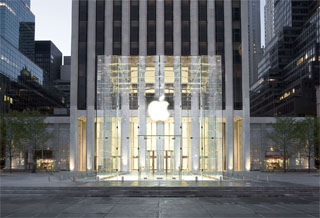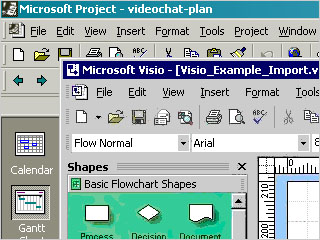
As I was subtly hinting at in my last couple of posts, I have changed my Windowy ways. I have switched (back) to Mac. Finally.
This is the first in an ad hoc series of articles documenting my experiences with this transition, looking at it from many perspectives: personal and cultural observations, usability and user experience design inspirations, and technology and business considerations. And, not least of all, I hope that it will also serve as my formal introduction to the Mac community that I have for many years only been able to observe from the outside.
How I Became a Windows Addict
After college, when I landed my first real multimedia-industry job in the early ’90s, I was required to use Windows (version 3.11) as my day-to-day work machine. I had never used Windows before — in fact, I’d never even seen Windows before. I instantly found it awkward to use, and I immediately recognized it to be a lower-quality imitation of the Mac OS. Still, it wasn’t long before I owned a Windows PC at home.
Little did I know that this would be the beginning of a thirteen-year relationship with Microsoft Windows.
Earlier in my life, between the ages of twelve and twenty-three, my computer platforms were very diverse, including the Apple II, the TRS-80, the TI-99/4a, and the only computer I actually owned myself before the age of twenty-five, the Commodore 64. My father had a Mac SE, and I experimented with Hypercard on it in High School. Later, as I made my way through art school at Cooper Union, the professional platforms of the Mac and the Commodore Amiga became my tools of choice.
At college, I focused on conceptual installation and sculpture. I didn’t take any design courses whatsoever. I was cutting steel and casting plastic and reading about Marcel Duchamp, not learning how to use Photoshop or manage Suitcases. As a result, my exposure to the Macintosh was unusually light compared to that of most people who would become design professionals. What’s worse, back in the early 90’s Cooper Union’s design department owned all of the art school’s Macs, and they were very strict about who could use them. For several years you were literally not permitted to use the computers in the Mac Lab until you had completed several prerequisite courses in setting movable type in a medieval letterpress! Very old school policy, one that pretty much put the Mac out of reach for me.
And then Windows entered my life.
In all the intervening time, over a dozen different computers, four jobs, and starting my own company, I never went back to Mac. I just kept renewing my vows with Windows. Has it really been thirteen years? It’s hard for me to even believe it.
Why I Waited So Long to Switch
Computer ownership involves a lot of inertia, a comfort with the status quo that’s hard to overcome. You become invested both in your own expertise and in the tools you own. In my case, I became a bona fide Windows “power user”, and a pretty decent Windows system administrator to boot, and I accumulated an extensive collection of PC components and peripherals, piled up in drawers and toolboxes all around my home office.
My reasons for sticking with Windows for thirteen years are pretty simple:

Games: My career began as a computer game designer. Naturally I was also a player. And all of the best and most innovative games in the mid-90’s were PC-based (this was in the console “dark ages”, the lull between the NES and Playstation eras). Desktop PCs were miles ahead of everything else, and the Macintosh was barely on the radar at all. One can only play so much Sim City, after all. From the classic graphic adventure games from LucasArts, to the great isometric sims and strategy games from Warcraft to Civilization, to the thrilling genesis of the first person genre with Doom, Quake, Half-Life, and Unreal, I was up to my knees in pixilated blood thanks to the smokin’ PC platform. The Macintosh offered me nothing.
Now, of course, the Mac has plenty of games available for it. And honestly I have less interest in games than I did five or ten years ago. And the best gaming, of course, is on the Nintendo Wii anyway.

Tinkering: One of the things I liked most about PCs was how easy and cheap it was to open them up and experiment with the hardware guts, and how much software there was for further mucking around. It wasas if I owned a fancy sports car that I could trick out in the garage every weekend. Over the years, I’ve built dozens of PC computers from scratch, scavenging parts from older computers, discount stores, and even from the trash. I’ve also accumulated a lot of software: apps, utilities, hacks, tweaks. But in the last couple of years, I have retired from my hobby of tinkering with computers. The first step was realizing that the amount of money I save by building a PC from scratch was not worth the hundreds of hours I’d invariably spend dealing with hardware incompatibilities, OS glitches, and assorted Windows and PC bullshit.
At some point I decided that I should be using my computer for things besides playing with my computer. Getting a Mac is definitely part of this philosophy.

Cost: In 1997, before the iMac came out, I could build three smokin’ Windows workstations for the price of a single low-end Mac. Even after the low-priced iMac came out, I really never saw the Mac as an affordable computer given my budget and salary at the time.
I’ll be frank here: The Macintosh has always been a luxury product, targeted at the higher ends of the American economic class scale. And even now that Apple’s pricing gets comparatively lower and lower, there are still millions of people who cannot justify the cost of a Mac when a powerful new Windows machine can still be had for half the price. It’s a Wal-Mart mentality, making significant sacrifices on style and even quality in favor of price, but it’s an approach that I can hardly begrudge millions of Americans for taking when the other option is economically impossible.
As much disdain as I have for the Windows PC platform, I will not stoop to berating people just because they cannot afford a fancy Macintosh computer. I’ve been there, and I know how it feels.
Which brings me to probably another reason lots of Windows users resent the Mac: It’s a class thing. For a long time, I didn’t want to identify with style-conscious and wealthy computer buyers who were willing to pay twice as much for something just because it carried a certain cachet. Conversely, there’s a certain admirable asceticism to using a PC, like wearing a hairshirt. I’ve gotten over it.

Visio, Project, and Outlook: At various stages of my career, Microsoft Project and Microsoft Visio have been the centers of my professional computing life. As a project manager, MS Project is the essential project planning tool in the business world, and as an information architect, Visio has always been the industry standard. And Outlook has always been my dashboard for my business PIM needs. I am an expert power user of all three of these programs, and all three are only available on Windows.
The emergence of windows-compatible Intel Macs have made all of this obsolete, since now Mac owners can run Windows on the same machine via Boot Camp, Parallels, or VMWare Fusion. In a pinch, I can always run these apps in a Windows partition on an Apple machine.
But more importantly, I have come to have faith in the emergence of alternative, non-MS tools for every single application MS currently has a stranglehold on. Tools that are not only just as functional as the MS products they seek to replace, but that are already achieving an astonishing amount of adoption momentum. People are using non-MS apps more and more every day, including, surprisingly, many people within our enterprise-level clients. OmniGraffle is fast becoming the preferred alternative to Visio among my fellow information architects, for example, and tools such as Merlin and are viable MS Project replacements.
But more generally, tools that go beyond the desktop and aren’t mere feature-by-feature replacements. Google Spreadsheets, for example, is superior to Excel for much of my spreadsheeting needs: I can share it over the internet, it saves versions automatically, and it’s far easier to use than Excel. 37Signals‘ Basecamp and Backpack do a lot of things that no project management or PIM software does. Google, Yahoo!, AIM, Twitter, and WordPress comprise a great deal of my day-to-day computing tools. None of these are anything like what Microsoft is developing for the desktop.
Down with the People: Finally, since I am a web user experience designer, it’s important that the tools I use allow me to understand and empathize with the tools my end users are using. Getting a Mac will surely decrease this empathy, but you know what? My Windows usage is so idiosyncratic that this empathy is probably minimal. Maybe I’m rationalizing, but again, I’ve gotten over this reason, too.
Why I am Switching
So clearly there are very few good reasons for me to stay with Windows, besides pure inertia. So why should I upend my entire computer life and adopt a whole new platform? That’s for next time, Why I am Switching: What I Expect and What I Fear.
Comments
8 responses to “Back to Mac, Part 1: Why I am Leaving Windows and Getting a Mac”
ru gettin’ a tower, an iMac or a macbook (pro)?
Strangely, the towers are so huge now that I don’t even want one (plus I already have an old single cpu G5 that works fine). I don’t even know that they call the intel towers…
…Mac Pro — just looked it up 😉
I’m currently going through my own conversion, but in my case it’s from Windows to Ubuntu, but I find it very interesting that my reasons are very similar to yours. The software I use daily that isn’t web-based is all open source, like Gimp, Audacity and Open Office, all of which I use in Windows anyway. Besides, once you go through the (grueling, intense, wicked) installation, Ubuntu is Mac-like in it’s user-friendliness, only better — and I’m entirely prejudiced when I say that.
The fact that everything but the hardware is free certainly helps, but as far as I’m concerned, Mac and Linux are about equal at the end of the day as Windows alternatives. It’s just a matter of whether you have time or money to throw at your problem. You can buy a shiny new computer that’s ready to fly out of the box, or you can take an old computer and build your system from the ground up, and either way you end up with a user-friendly box that does what you want it to do.
one thing that has always been brought up by friends urgin me to switch is the better response and speed in how mac handle design softwares like photoshop and all.
for the moment, the games are keeping me here on the pc. perhaps in the near future when the price gets to a more affordable level for me:)
I’m looking forward to Part II.
My first machine was a Commodore 64 too … gifted to me by my father.
“So why should I upend my entire computer life and adopt a whole new platform?”
Hmmm, doesn’t have anything to do with that “Experience” post from a while back, does it? 🙂
Back in my early teen years, all of us computing geeks were firmly split into two camps: the Apple II crowd, and the Atari 800 crowd. Fierce loyalty, you wouldn’t even be seen hanging out with one from the other side. Funny enough, the Commodore was Switzerland — both camps could appreciate it, and Commodore users could move freely about. Ah, the good ol’ days.
@Sroka: I always sorta thought of the Commodore as Ireland — dirt poor but full of ideas.
ok – how do I read the next post??